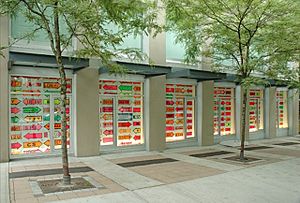Contemporary art facts for kids
Contemporary art can be defined variously as art produced at this present point in time or art produced since World War II. The definition of the word contemporary would support the first view, but museums of contemporary art commonly define their collections as consisting of art produced since World War II.
Contents
The institutions of contemporary art
Contemporary art is exhibited by commercial contemporary art galleries, private collectors, corporations, publicly funded arts organizations, contemporary art museums or by artists themselves in artist-run spaces. Contemporary artists are supported by grants, awards and prizes as well as by direct sales of their work.
There are close relationships between publicly funded contemporary art organisations and the commercial sector. For instance, in Britain a handful of dealers represent the artists featured in leading publicly funded contemporary art museums.
Individual collectors can wield considerable influence. Charles Saatchi has dominated the contemporary art market in Britain since the 1980s; the subtitle of the 1999 book Young British Artists: The Saatchi Decade uses of the name of the private collector to define an entire decade of contemporary art production.
Corporations have attempted to integrate themselves into the contemporary art world: exhibiting contemporary art within their premises, organising and sponsoring contemporary art awards and building up extensive collections.
The institutions of art have been criticised for regulating what is designated as contemporary art. Outsider art, for instance, is literally contemporary art, in that it is produced in the present day. However, it is not considered so because the artists are self-taught and are assumed to be working outside of an art historical context. Craft activities, such as textile design, are also excluded from the realm of contemporary art, despite large audiences for exhibitions. Attention is drawn to the way that craft objects must subscribe to particular values in order to be admitted. "A ceramic object that is intended as a subversive comment on the nature of beauty is more likely to fit the definition of contemporary art than one that is simply beautiful."
At any one time a particular place or group of artists can have a strong influence on globally produced contemporary art; for instance New York artists in the 1980s.
Public attitudes
Contemporary art can sometimes seem at odds with a public that does not feel that art and its institutions share its values. In Britain in the 1990s contemporary art became a part of popular culture, with artists becoming stars, but this did not lead to a hoped for "cultural utopia".
Concerns
A common concern since the early part of the 20th century is the question of what constitutes art. This concern can be seen running through the "modern" and "postmodern" periods. The concept of avant-garde may come into play in determining what art is taken notice of by galleries, museums, and collectors. Serious art is ultimately exceedingly difficult to distinguish definitively from art that falls short of that designation.
Contemporary art prizes
Some competitions, awards and prizes in contemporary art are:
- Emerging Artist Award awarded by The Aldrich Contemporary Art Museum
- Hugo Boss Prize awarded by the Solomon R. Guggenheim Museum
- Factor Prize in Southern Art
- Turner Prize for British artists under 50
- Jindrich Chalupecky prize for Czech artists under 35
- Participation in the Whitney Biennial
- Vincent Award, The Vincent van Gogh Biennial Award for Contemporary Art in Europe, founded by The Broere Charitable Foundation and hosted by Stedelijk Museum
- Marcel Duchamp Prize awarded by ADIAF and Centre Pompidou
- The Winifred Shantz Award for Ceramists, awarded by the Canadian Clay and Glass Gallery
- Ricard Prize for a French artist under 40
- Deste Prize for young Greek artists, held every two years; funded by Dakis Joannou
- John Moore’s Painting Prize
History
This table lists art movements by decade. It should not be assumed to be conclusive.
1950s
|
1960s
|
1970s
|
1980s
|
1990s
|
2000s
|
Images for kids
-
Irbid, Jordan, "We are Arabs. We are Humans". Inside Out is a global participatory art project, initiated by the French photographer JR, an example of Street art
-
The Château de Montsoreau-Museum of Contemporary Art (France), is a private institution based in a Renaissance castle.
See also
 In Spanish: Arte contemporáneo para niños
In Spanish: Arte contemporáneo para niños







